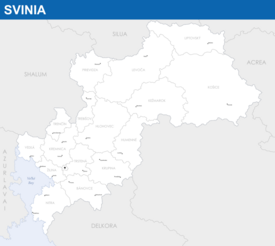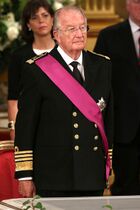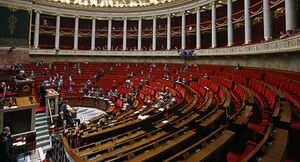User:Lihnidos/Sandbox2: Difference between revisions
No edit summary |
No edit summary |
||
| Line 41: | Line 41: | ||
|leader_title1 = [[Monarchy of Svinia|Emperor]] | |leader_title1 = [[Monarchy of Svinia|Emperor]] | ||
|leader_name1 = [[Drahoslav IV of Svinia|Drahoslav IV]] | |leader_name1 = [[Drahoslav IV of Svinia|Drahoslav IV]] | ||
|leader_title2 = [[ | |leader_title2 = [[Premier of Svinia|Premier]] | ||
|leader_name2 = [[Marián Kudrna]] | |leader_name2 = [[Marián Kudrna]] | ||
|leader_title3 = | |leader_title3 = | ||
| Line 159: | Line 159: | ||
==Politics== | ==Politics== | ||
{{main|Politics of Svinia}} | |||
===Government=== | |||
{| class="wikitable" style="text-align:left; float:right; margin-right:9px; margin-left:2px;" | |||
|- | |||
| style="text-align:left;"| [[File:DrahoslavIVSvinia.jpg|140px]] || style="text-align:left;" | [[File:Bachmann2011.jpg|170px]] | |||
|- | |||
| style="text-align:center;"|[[Drahoslav IV of Svinia|Drahoslav IV]]<br /><small>[[Monarchy of Svinia|Emperor]] since 1985</small> | |||
| style="text-align:center;"|[[Marián Kudrna]]<br /><small>[[Premier of Svinia|Premier]] since 2012</small> | |||
|} | |||
Svinia is a {{wpl|Federalism|federal}}, {{wpl|Parliamentary system|parliamentary}}, {{wpl|constitutional monarchy}}. The Svinian political system is laid out in the 1849 constitution approved by the monarch at the time, Radovan IV, that later underwent significant reforms in 1940. Further amendments to the constitution require a two-thirds majority in both the [[National Assembly of Svinia|National Assembly]] and [[Senate of Svinia|Senate]], as well as approval of two-thirds of each state legislatures and the monarch. The 1940 reforms strengthened the principle of separation of powers by increasing the powers of the legislature and limiting executive authority held by the monarch. | |||
The executive branch is led by the monarch, currently [[Monarchy of Svinia|Emperor]] [[Drahoslav IV of Svinia|Drahoslav IV]]. The monarch is the {{wpl|head of state}} and exercises their executive power through the Office of the Emperor (or Empress), also known as the Imperial Office. The monarch has representative responsibilities and powers and takes a significant role in establishing foreign policy. Each monarch begins their reign following the death of their predecessor. The monarch is considered to be the highest official in the Svinian government. | |||
The second-highest official in the Svinian government is the [[Premier of Svinia|Premier]]. The current Premier is [[Marián Kudrna]], who has led the government in the National Assembly since 2012. The Premier is the {{wpl|head of government}} and the legislative branch. Alongside their legislative duties, the Premier exercises their executive power through their [[Cabinet of Svinia|Cabinet]]. The Premier and Cabinet exercise executive power in conjunction with the monarch. | |||
[[File:SviniaNationalAssemblyChamber.jpg|300px|thumb|left|The National Assembly is the lower house of the Svinian Parliament.]] | |||
Legislative power is exercised by the [[National Assembly of Svinia|National Assembly]] and [[Senate of Svinia|Senate]]. Together, the National Assembly and Senate form the bicameral legislature of Svinia and each hold different roles. The National Assembly is elected through {{wpl|direct elections}} by {{wpl|mixed-member proportional representation}}. Elections for the National Assembly are held a minimum of every four years. The Senate is a collection of representatives from the seventeen states and are appointed by state cabinets. Representation for each state is determined by the state's population. | |||
The current government is a coalition government led by the [[Conservative Party of Svinia|Conservative Party]] with the [[National Party of Svinia|National Party]] as a junior partner. Together, the Conservative Party and National Party hold a slim majority in the National Assembly. Since the creation of the National Assembly under the constitution in 1849 the Conservative Party has been one of the two major political parties that have dominated elected politics. The other major political party in Svinia is the [[Liberal Democratic Party of Svinia|Liberal Democratic Party]]. Since 1936, every premier has been a member of either the conservatives or liberal democrats. | |||
===Law=== | ===Law=== | ||
Revision as of 00:23, 19 May 2019
Empire of Svinia Ríše Švíka (Svin) | |
|---|---|
|
Flag | |
| Motto: Sledovať svoje vlastné hviezdu ("Follow your own star") | |
| Anthem: Nad Tatrou sa blýska ("Lightning over the Tatras") | |
 | |
| Capital | Hrabské |
| Largest | Sveta |
| Official languages | Svin |
| Recognised regional languages | German Acrean Standard |
| Ethnic groups | 74.9% Svin 10.3% Shalumite 4.1% Acrean 10.7% Other |
| Demonym(s) | Svinian |
| Government | Federal parliamentary constitutional monarchy |
• Emperor | Drahoslav IV |
• Premier | Marián Kudrna |
| Senate | |
| National Assembly | |
| Formation | |
• Founding of Svinia | 600 BC |
• Under the Acrean Empire | 400 BC - 460 AD |
• Svinian Empire | 600 AD |
• First constitution | 1849 |
• Justínan reforms | 1940 |
| Area | |
• | 1,455,055 km2 (561,800 sq mi) |
| Population | |
• 2018 estimate | 193,541,235 |
• 2014 census | 191,693,965 |
• Density | 131.75/km2 (341.2/sq mi) |
| GDP (PPP) | 2019 estimate |
• Total | $7.814 trillion |
• Per capita | $40,762.89 |
| Gini | 41.7 medium |
| HDI | .856 very high |
| Currency | Koruna ( |
| Date format | dd.mm.yyyy |
| Driving side | right |
| Calling code | +57 |
| ISO 3166 code | SV |
| Internet TLD | .svn |
Etymology
History
Prehistory
Slavic tribes and Acrean Empire
Slavic states
Svinian Empire
Constitution and reforms
Contemporary period
Geography
Climate
Biodiversity
Politics
Government
 |

|
| Drahoslav IV Emperor since 1985 |
Marián Kudrna Premier since 2012 |
Svinia is a federal, parliamentary, constitutional monarchy. The Svinian political system is laid out in the 1849 constitution approved by the monarch at the time, Radovan IV, that later underwent significant reforms in 1940. Further amendments to the constitution require a two-thirds majority in both the National Assembly and Senate, as well as approval of two-thirds of each state legislatures and the monarch. The 1940 reforms strengthened the principle of separation of powers by increasing the powers of the legislature and limiting executive authority held by the monarch.
The executive branch is led by the monarch, currently Emperor Drahoslav IV. The monarch is the head of state and exercises their executive power through the Office of the Emperor (or Empress), also known as the Imperial Office. The monarch has representative responsibilities and powers and takes a significant role in establishing foreign policy. Each monarch begins their reign following the death of their predecessor. The monarch is considered to be the highest official in the Svinian government.
The second-highest official in the Svinian government is the Premier. The current Premier is Marián Kudrna, who has led the government in the National Assembly since 2012. The Premier is the head of government and the legislative branch. Alongside their legislative duties, the Premier exercises their executive power through their Cabinet. The Premier and Cabinet exercise executive power in conjunction with the monarch.
Legislative power is exercised by the National Assembly and Senate. Together, the National Assembly and Senate form the bicameral legislature of Svinia and each hold different roles. The National Assembly is elected through direct elections by mixed-member proportional representation. Elections for the National Assembly are held a minimum of every four years. The Senate is a collection of representatives from the seventeen states and are appointed by state cabinets. Representation for each state is determined by the state's population.
The current government is a coalition government led by the Conservative Party with the National Party as a junior partner. Together, the Conservative Party and National Party hold a slim majority in the National Assembly. Since the creation of the National Assembly under the constitution in 1849 the Conservative Party has been one of the two major political parties that have dominated elected politics. The other major political party in Svinia is the Liberal Democratic Party. Since 1936, every premier has been a member of either the conservatives or liberal democrats.

